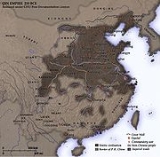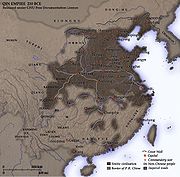

in 150 BCE. Donghu was later divided into the Wuhuan
and Xianbei
Confederations, from which the Mongols are derived. Hence, in modern linguistic terminology, they are classified as a proto-Mongolic nomadic ethnic group
.
Name
The Chinesename Donghu compounds
dong 東 "east, eastern; owner; host" and hu 胡 "non-Han-Chinese, foreign, 'barbarian'; reckless; dewlap; whiskers (hu 鬍); surname
". The "Eastern" Donghu exonym compares with "Western" Xihu 西胡 "non-Chinese peoples in India
, Persia, Turkestan
, etc." and "Five" Wu Hu
五胡 "five northern nomadic tribes involved in the Wu Hu uprising
(304-316 CE)". Hill (2009:59) translates Xihu as "Western Hu" and notes,
The term hu 胡 was used to denote non-Han ChineseHan ChineseHan Chinese are an ethnic group native to China and are the largest single ethnic group in the world.Han Chinese constitute about 92% of the population of the People's Republic of China , 98% of the population of the Republic of China , 78% of the population of Singapore, and about 20% of the...
populations. It is, rather unsatisfactorily, commonly translated as 'barbarian'. While sometimes it was used in this general way to describe people of non-Han descent, and carried the same negative overtones of the English term, this was not always the case. Most frequently, it was used to denote people, usually of Caucasoid appearance, living to the north and west of China. (2009:453)
The usual English translation of Donghu is "Eastern Barbarians" (e.g., Watson, di Cosmo, Pulleyblank, and Yu), and the partial translation "Eastern Hu" is occasionally used (Pulleyblank). Note that "Eastern Barbarians" also commonly translates the Chinese exonym Dongyi
東夷 "ancient peoples in eastern China, Korea, Japan, etc.".
The ancient Chinese Sinocentric worldview differentiated central Hua or Huaxia
"China, Chinese" and peripheral Yi 夷 "barbarian, non-Chinese, foreigner" (see Hua-Yi distinction
). Many names besides Hu originally had pejorative
"barbarian" meanings, for instance Nanman
南蠻 ("southern barbarians") and Beidi
北狄 ("northern barbarians"). The sinologist Edwin G. Pulleyblank
explains:
At the dawn of history we find the Chinese, self-identified by such terms as Hsia and Hua, surrounded and interspersed by other peoples with whom they were frequently in conflict and whom they typically looked down upon as inferior beings in the same was the Hellenes looked down on the barbaroi and, indeed, as human we-groups have always looked down on their neighbors.
The historian Nicola di Cosmo concludes:
We can thus reasonably say that, by the end of the fourth century B.C., the term "Hu" applied to various ethnic groups (tribes, groups of tribes, and even states) speaking different languages and generally found living scattered across a wide territory. Their fragmentation, however, could be turned, when the need arose, into a superior form of political organization (a "state"). This explains why hu appears often preceded by a qualifier that we may take for a specific ethnic goup, as with the Lin HuLin HuLin Hu, 林虎, was a member of the Old Guangxi Clique and military governor of Guangdong province from May 1924 to July 1925.-Early life and career:...
and the Tung Hu. Whether or not it had originally been an ethnonym, such a designation had been lost by the Warring States period.
In Modern Standard Chinese usage hu has lost this negative connotation and typically means "foreign; imported" in words like erhu
二 胡 (lit. "two foreign") "Chinese two-string fiddle", hutiao 胡桃 ("foreign peach") "walnut
", and huluobo 胡萝卜 ("foreign radish") "carrot
".
The modern Chinese Dōnghú 東胡 and Mongolian language
Tünghu pronunciations historically differ from the Old Chinese
pronunciation, which roughly dates from the Warring States Period (476-221 BCE) when Donghu was first recorded. Old Chinese reconstructions of Dōnghú include *Tûngγâg, *Tungg'o, *Tewnggaγ, *Tongga, and *Tôŋgâ.
The etymology of Donghu is "unknown". The traditional explanation, going back to the 2nd-century Han scholar Cui Hao 崔浩, is that the Donghu were originally located "east of the Xiongnu
" (who were one of the Wu Hu). A modern politically correct
explanation is that Chinese Donghu or Mongolian Tünghu was an ethnonym
transcription and did not literally mean "Eastern Barbarian".
Some dictionaries confuse Donghu 東胡 with Tungus; Tungusic people (Chinese Tonggu 通古). This "chance similarity in modern pronunciation", writes Pulleyblank, "led to the once widely held assumption that the Eastern Hu were Tungusic in language. This is a vulgar error with no real foundation."
History
Among the northern ethnic groups, the Donghu was the earliest to evolve into a state of civilization and first developed bronzetechnology. They spoke proto-Mongolian language
and their culture was associated with the Upper Xiajiadian culture
, characterized by the practice of agriculture and animal husbandry supplemented by handicrafts and bronze art. Through the use of cavalry and bronze weaponry in warfare, they dominated over the Xiongnu
on their west.
The (ca. 109-91 BCE) Shiji section on Xiongnu
history first records the Donghu during the era of Duke Wen of Jin
(r. 697-628 BCE) and Duke Mu of Qin
(r. ca. 659-621 BCE).
At this time Qin and Jin were the most powerful states in China. Duke Wen of Jin expelled the Di
Di (ethnic group)The Di were an ethnic group in China from the 8th century BCE to approximately the middle of the 6th century CE. Note that the character Di is used to differentiate this group from the Beidi , a generic term for "northern barbarians". They lived in areas of the present-day provinces of Gansu,...
barbarians and drove them into the region west of the Yellow RiverYellow RiverThe Yellow River or Huang He, formerly known as the Hwang Ho, is the second-longest river in China and the sixth-longest in the world at the estimated length of . Originating in the Bayan Har Mountains in Qinghai Province in western China, it flows through nine provinces of China and empties into...
between the Yun and Luo rivers; there they were known as the Red Di and the White Di. Shortly afterwards, Duke Mu of Qin, having obtained the services of You Yu, succeeded in getting the eight barbarian tribes of the west to submit to his authority.
Thus at this time there lived in the region west of LongGansu' is a province located in the northwest of the People's Republic of China.It lies between the Tibetan and Huangtu plateaus, and borders Mongolia, Inner Mongolia, and Ningxia to the north, Xinjiang and Qinghai to the west, Sichuan to the south, and Shaanxi to the east...
the Mianzhu, the Hunrong, and the Diyuan tribes. North of Mts. Qi and Liang and the Jing and Qi rivers lived the Yiqu, Dali, Wuzhi, and Quyuan tribes. North of Jin were the Forest Barbarians and the Loufan, while north of Yan lived the Eastern Barbarians and Mountain Barbarians, each of them with their own chieftains. From time to time they would have gatherings of a hundred or so men, but no one tribe was capable of unifying the others under a single rule.
In 300 BCE Qin Kai, a general taken hostage from the state of Yan (whose capital "Ji" is now present-day Beijing
), defeated the Donghu after having gained the esteem of the Donghu and learning their battle tactics. By the time of the rule of the Xiongnu
Chanyu
Touman (c. 220 BCE to 209 BCE), ". . . the Eastern Barbarians were very powerful and the Yuezhi
were likewise flourishing." When the Xiongnu crown prince Modu Chanyu killed his father, Touman (in 209 BCE) and took the title of Chanyu, the Donghu thought that Modu feared them, and they started to ask for tribute from the Xiongnu, and even a consort of Modu's. Not satisfied with this they asked for some of the Xiongnu territories. This enraged Modu who attacked and soundly defeated them, killing their ruler, taking his subjects prisoner, and seizing their livestock, before turning west to attack and defeat the Yuezhi (c. 177 BCE).
This caused disintegration in the Donghu federation. Thereafter, the Wuhuan
moved to Mt. Wuhuan and engaged in continuous warfare with the Xiongnu on the west and China on the south. As they came to be worn out from the lengthy battles, the Xianbei
preserved their strengths by moving northward to Mt. Xianbei. In the 1st century, the Xianbei defeated the Wuhuan and northern Xiongnu, and developed into a powerful state under the leadership of their elected Khan
, Tanshihuai.
Chinese historian Yu Ying-shih
describes the Donghu.
The Tung-hu peoples were probably a tribal federation founded by a number of nomadic peoples, including the Wu-huan and Hsien-pi. After its conquest of the Hsiung-nu, the federation apparently ceased to exist. Throughout the Han period, no trace can be found of activities of the Tung-hu as a political entity.
Di Cosmo says the Chinese considered the Hu 胡 as "a new type of foreigner", and believes, "This term, whatever its origin, soon came to indicate an 'anthropological type' rather than a specific group or tribe, which the records allow us to identify as early steppe nomads. The Hu were the source of the introduction of cavalry in China."
Pulleyblank cites Paul Pelliot
that the Donghu, Xianbei, and Wuhuan were "proto-Mongols".
The Eastern Hu, mentioned in the Shih-chi along with the Woods Hu and the Lou-fan as barbarians to the north of Chao in the fourth century B.C., appear again as one of the first peoples whom the Hsiung-nu conquered in establishing their empire. Toward the end of the Former Han, as the Hsiung-nu empire was weakening through internal dissension, the Eastern Hu became rebellious. From then on they played an increasingly prominent role in Chinese frontier strategy as a force to play off against the Hsiung-nu. Two major divisions are distinguished, the Hsien-pei to the north and the Wu-huan to the south. By the end of the first century B.C. these more specific names had supplanted the older generic term.
Pulleyblank also writes,
Although there is now archaeological evidence of the spread of pastoral nomadism based on horse riding from Central Asia into Mongolia and farther east in the first half of the first millennium B.C.E., as far as we have evidence it did not impinge on Chinese consciousness until the northward push of the state of Zhao 趙 to the edge of the steppe in present Shanxi province shortly before the end of the fifth century B.C.E. brought them into contact with a new type of horse-riding “barbarian” that they called Hu 胡. … In Han times the term Hu was applied to steppe nomads in general but especially to the Xiongnu who had become the dominant power in the steppe. Earlier it had referred to a specific proto-Mongolian people, now differentiated as the Eastern Hu 東胡, from whom the Xianbei 鮮卑 and the Wuhuan 烏桓 later emerged.
External links
- The Hu Peoples, Silk Road Seattle Virtual Art Exhibit.
- Non-Chinese peoples and neighboring states: Hu 胡, ChinaKnowledge.

